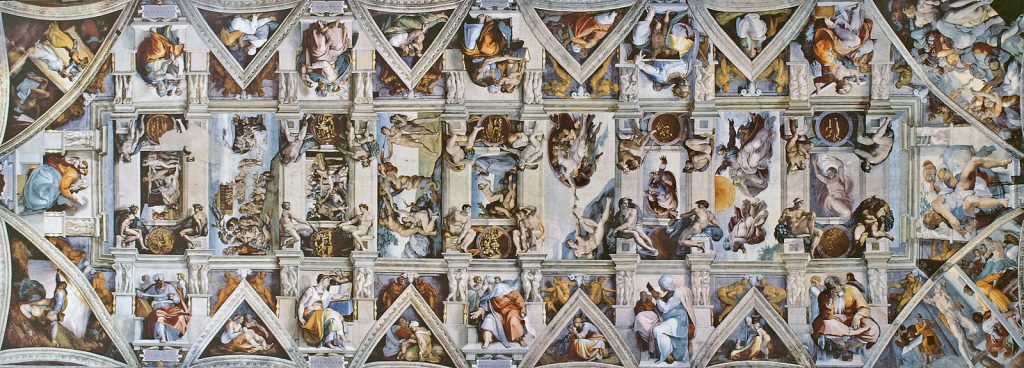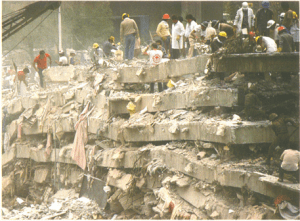From 1508 to 1512, it took Michelangelo five long, torturous years to complete the rigorous task of painting the ceiling of the Sistine Chapel. Spanning more than 10,000 square feet, the iconic piece of high Renaissance art is familiar to many people. Nevertheless, despite Michelangelo’s distinct ability to imply powerful expression and emotion into his art, most people fail to interpret the full story behind the talented artist’s five-year journey. Many may not realize that the beautiful, intricate depictions attributed to Michelangelo were actually painted by an unskilled artist. Likewise, one would not even dare think that the hand behind the brush had minimal interest in painting such marvelous masterpieces.
Michelangelo was by no means recognized as a skilled painter in his time. His fame, rather, came from the sculptures he chiseled in Rome and in Florence in his earlier years. His first sculpture in Rome was Bacchus (1496-1497), which he sculpted for a French ambassador’s barber. The French ambassador then commissioned Angelo to sculpt the Pietà (1498-1499). It was to be Michelangelo’s first contribution to the Catholic Church. The sculpture depicted the Virgin Mary holding the dead body of Jesus Christ. It was widely admired for the pure and simple expression of Mary and the holy serenity of Jesus even in the stillness of death. A few projects later, Angelo worked in Florence, sculpting the massive statue of the biblical hero David. The sculpture David (1501-1504) left Florentine citizens and artists, such as Leonardo Da Vinci, in awe. Eventually, he was assigned to work with Da Vinci painting war cartoons on the walls of the great municipal hall of Florence, known as the Palazzo Vecchio. After treating Da Vinci with severe discourtesy, he was summoned to Rome, by Pope Julius II for a new commission in 1505.1

Upon arriving in Rome, Michelangelo was employed to work on a mausoleum, or sepulcher, for the pope. Julius desired a tomb spanning eight hundred square feet, three stories high, and adorned with twenty six statues. He was willing to pay Michelangelo more than two hundred thousand crowns to complete the grand project. However, the pope’s desires were too extravagant and the expense was absurdly high, so the St. Peter’s basilica, where he desired his tomb to lay, would not allow it. Julius II and Angelo had developed an intimate friendship at this point, as they shared a proud, willful, and honest character. It was tough love between them; they always found a way to reconcile after constant quarreling and the loss of each others’ trust. Suddenly, however, after being denied his mausoleum, the pope’s demeanor changed and he excluded Angelo from the Vatican.2 Donato Bramante, a papal Italian architect, instigated this trouble by warning the pope of the evil omen he invited by constructing his death monument during his lifetime. Jealous of Angelo’s illustrious talent, Bramante encouraged Julius to hire Michelangelo to paint the ceiling of the Sistine Chapel instead, hoping that he would fail miserably. Meanwhile, triggered by his banishment, Michelangelo decided to abandon the pope and return to Florence.3
Three years later, in 1508, after multiple attempts by the pope to forcibly return the skilled artists to Rome, Michelangelo finally met with him. The pope hired him to paint frescoes of the twelve Apostles on the Sistine Chapel ceiling, but Angelo hesitated, knowing that he had inadequate practice with fresco-painting. Nonetheless, Julius repeatedly urged Angelo to accept the job, until finally, Angelo reluctantly gave consent under one condition.4 Michelangelo asked that something more tasteful be painted on the ceiling; he wanted to be allowed to “do as he pleases.” He suggested nine scenes from the book of Genesis, beginning with the creation of the world and ending with Noah and the flood.5

The pope granted his request, and Michelangelo started right away. Bramante was given the task of constructing the scaffolding, but his approach was inefficient and it made holes in the ceiling. This angered Angelo so much that he got the pope’s permission to banish Bramante, and he make the scaffold himself. After making a better scaffold structure, Michelangelo still doubted his abilities for the task, so he summoned his childhood friend, Francesco Granacci, to aid him in preparing designs for the frescoes. Angelo got the hang of it quickly, and soon enough, Granacci and two other assistants were painting over the master’s chalk outlines. Michelangelo’s arrogance engulfed him though, and he regretted inviting his three assistants, who could not express the art in harmony with his detailed ideas. He sent his friends back to Florence and set forth on the project alone, where he spent most of his days alone in the sombre space between the platform and the ceiling. Michelangelo became frustrated; he ached daily from having his head thrown back, spine arched downward, and face covered in paint. Matters only got worse as the winter neared.6
From May until the first winter, nearly one third of the ceiling was complete, but it was all ruined by mold that developed under the perfect conditions of the cold weather and moisture in the Roman lime Michelangelo used to make the plaster. Devastated, Angelo gave up, and shouted to the pope, “I told you I was no fresco-painter; what I have done is ruined.” He took a break from the project for nearly a year, as he waited for favorable weather and for the mold to disappear. It was after this break that Michelangelo’s frescoes underwent an evident change. The paintings became larger and more expressive and emotional. He continued the back-breaking work until it was finally completed in 1512.7
Notably, one well-known fresco that depicts The Creating of Adam, clearly demonstrates Michelangelo’s shift in form and style. The large twisted bodies are very expressive, and the movements portray a strong emotion that can be easily perceived, even from the chapel ground! This style completely contrasts Angelo’s first few frescoes, which were small and complicated. In particular, the scene of The Great Flood is full of action when viewed up close. The fresco contains four stories alone, but they cannot be seen well from the ground. Michelangelo was aware of this issue, but he decided not to feed his frustration and continued painting the ceiling, with the new approach.

Completing the job was not easy for Michelangelo, he had to fight through the strong hatred he developed while painfully painting the frescoes. Some scholars believe that Michelangelo suffered from deconditioning syndrome, which is a state of physical and emotional lethargy as a result of a lack of exercise or movement for long periods of time.8 However, this is due to a common misconception that he worked laying down on the scaffolds, close to the ceiling. In fact, Michelangelo spent hours upon hours with his head bent back, his spine curling in on itself, and his feet aching because he painted standing upright on his designed scaffold. He regretted ever accepting the task; he even wrote a poem in 1509 describing how much he loathed the whole situation:
From the year 1513, when the chapel finally reopened to the public, until the present day, Michelangelo’s arduous accomplishment lives on as a renowned piece of art. The paintings have acquired a low tone due to withering and reckless care, but they still stand to show that he conquered the task and surpassed those who doubted him. Although it may have costed him physical and mental health, his dedication and skill continue to inspire artists and historians, and astonish all those who view his works.10

- Moses Sweetser, Michael Angelo (Michigan: Houghton, Osgood and company, 1878), 23-35. ↵
- Moses Sweetser, Michael Angelo (Michigan: Houghton, Osgood and company, 1878), 34. ↵
- “Michelangelo’s Painting of the Sistine Chapel Ceiling,” ItalianRenaissance.org, May 9, 2013, http://www.italianrenaisance.org. ↵
- Moses Sweetser, Michael Angelo (Michigan: Houghton, Osgood and company, 1878), 48-49. ↵
- “Michelangelo’s Painting of the Sistine Chapel Ceiling,” ItalianRenaissance.org, May 9, 2013, http://www.italianrenaissance.org ↵
- Moses Sweetser, Michael Angelo (Michigan: Houghton, Osgood and company, 1878), 50. ↵
- Andrew Graham-Dixon, Michelangelo and the Sistine Chapel (New York: Skyhouse Pub, 2009), 1-35. ↵
- Raffaella Bianucci et al., “Michelangelo Buonarroti (1475-1564) had the Deconditioning Syndrome While painting the Sistine Chapel Ceiling,” Medical Hypotheses 113, (April 2018): 13-14. ↵
- Gail Mazur, “Michelangelo: To Giovanni Da Pistoia When the Author Was Painting the Vault of the Sistine Chapel,” Poetry 1, no. 1 (2005): https://www.poetryfoundation.org/poems/57328. ↵
- Moses Sweetser, Michael Angelo (Michigan: Houghton, Osgood and company, 1878), 57-58. ↵



120 comments
Jose Fernandez
Congratulations on the nomination! The images you chose for the article are very eye catching. Even though I knew about Michelangelo’s creations, I didn’t know much about his life, and its important to also know how he started his career. The ceiling of the Sistine Chapel is one of the greatest works of art in human history, in my opinion. I think we are all lucky that Michelangelo was so passionate about art and kept going despite the difficulties. He faced adversity early on, but he continued to pursue his passion. I want to see the Sistine Chapel with my own eyes one day.
Pamela Callahan
Great article! I had no idea that Michelangelo didn’t want to paint the Sistine Chapel. I always thought that something that was painted that well must have been due to the artists motivation and their desire to do well, but after reading this article, it seems like Michelangelo had neither. His work is truly awe-inspiring and even though he may not have enjoyed creating it, I think it was God’s will that he completed the grand task for all to see.
Julissa Cantu
While the format was very nice, the sentence structures of the entirety of the article could have been more exciting considering some of the subject matter. A good tip for future writing for Arreola would be the reminder that these are people. Sometimes longer sentences take the human emotions from these instances when they should be fast and angry, as was the situation with the Pope, or slow and patient, as the events would have been with Michelangelo painting the Sistine Chapel. Overall, the article was very informative.
Greyson Addicott
Although there are many beautiful works of art throughout Rome, I believe we hardly think of the great minds behind them. At the height of their ability, there was arguably no better “Renaissance man” than Michael Angelo. This article went to great lengths to describe the back-breaking process of painting the Sistine Chapel in intricate detail, from the hiring and firing of different workers to the mold that attacked Angelo’s painting. Truly, this article well deserves an award!
Steven Hale
Looking at the images of Michelangelo’s paintings, it is hard to believe he was not always recognized as a painter. I cannot imagine the commitment and skill it took to paint the Sistine Chapel, especially since he was not too excited about the project. The physical toll or setbacks from the weather and mold would be more than enough to stop most people.
Martina Rodriguez
I loved the first image of the article. I’ve only seen sections of the chapels ceiling, so to see the full image was very cool. I’ve seen Michelangelo’s sculptures before, but I had no idea that it was those were more famous than his art. I had never heard of the turmoil with the pope, what a fascinating story. I also had no idea that he had called upon three assistants, but I wasn’t surprised at his arrogance towards their progress. I loved the use of the poem in the article! Lovely article, the authors way with words made for an enjoyable read.
Luke Lopez
This was a very interesting article on Michelangelo, and his many pieces of art. I did not know that Michelangelo was considered rather unskilled when it came to painting. He rose to fame through his sculptures that he had created. The images used in this article were a fine addition to this article. Overall, this was a great article that detailed the many different works of Michelangelo.
Jose Sanchez
Art and art history are probably one of the areas I am least knowledgeable in. Your article did a great job explaining the history behind Michelangelo’s paintings. It is impressive he was able to create such beautiful work while under pressure, bad working conditions, and all the set backs he faced. He was very dedicated to finishing this no matter the cost.
Marina Castro
Interesting article! Congratulations Jonathan Arreola for the nomination of Best Use of Images on your article. Your article is one of the shortest articles nominated for an award, but it is still really good. The length of the article in this case did not influence at all the quality of it. The images you used are great and the article would certainly be incomplete without it.
Mia Stahl
Michael Angelo is without a doubt one of the most renowned artists in the history of the world. Particularly his sculpting abilities were recognized because he sculpted so precisely that he could make marble look like water. His work with Di Vinci was also one of the greatest collaborations within the art community. His work within the Sistine Chaple has and will continue to awe generations to come of the pure talent that Michael Angelo possessed.